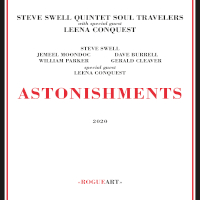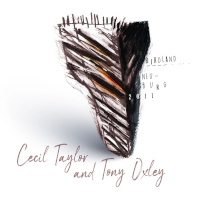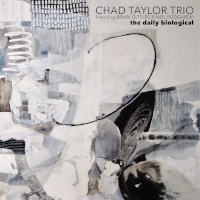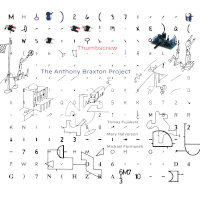Moment's Notice
Reviews of Recent Recordings
(continued)
Roots Magic
Take Root Among the Stars
Clean Feed CF545CD
 Instrument inventor Phil Cohran composed “Frankiphone Blues” to be a played on a frankiphone, his electrically amplified kalimba. In Roots Magic’s version, Franceso Lo Cscio’s vibes sound very much like a frankiphone. Mainly, what makes this track special is Eugenio Columbo flutter-tonguing a wow of a flute solo that glides over the dancing Cohran-band-like rhythm section. The other piece that stays close to the feeling of the original is “Still Screaming for Charles Tyler,” merry energy music with two early folk-like Tyler themes.
Instrument inventor Phil Cohran composed “Frankiphone Blues” to be a played on a frankiphone, his electrically amplified kalimba. In Roots Magic’s version, Franceso Lo Cscio’s vibes sound very much like a frankiphone. Mainly, what makes this track special is Eugenio Columbo flutter-tonguing a wow of a flute solo that glides over the dancing Cohran-band-like rhythm section. The other piece that stays close to the feeling of the original is “Still Screaming for Charles Tyler,” merry energy music with two early folk-like Tyler themes.
For three-fourths of this fine CD, Roots Magic is clarinetist/bass clarinetist Alberto Popolla, alto/baritone saxist Errico De Fabritis, bassist Gianfranco Tedeschi, and percussionist Fabrizio Spera. Their repertoire comes from very early country bluesmen and the first two generations of outside players. Indeed, they capture the composers’ original feelings in part in most tracks before leaping into their unique reinterpretations. In 1969, Maurice McIntyre recorded “Humility in the Light of the Creator” as a beautiful, stark Appalachian ballad. Roots Magic turns that feeling into a drama that swells to a big climax. BTW: most musicians who play this song call it by its original title. The sloppy designer of the original Delmark LP cover mistitled the album with “of Creator.” Most annoyingly, Delmark’s CD reissue now has also retitled the song with “of Creator,” and this album repeats the blunder – not Roots Magic’s fault, of course.
Sun Ra’s ballad “When There Is No Sun” becomes a slow funky blues plus some screaming woodwinds in Roots Magic’s drastic revision. Zither strums, gong, rattling little percussion, and clarinet turn John Carter’s “Karen on Monday” into a pastoral free improvisation worthy of the early Art Ensemble. Ornette Coleman’s “A Girl Named Rainbow” is the album’s ballad, with bass and drums rising and falling, rising and falling behind the horns’ fugue. Skip James’ 1931 “Devil Got My Woman” turns into some program music with a virtuoso bass solo to start, dark and heavy slow drums behind the theme, then hellish bass clarinet screams over the threats of the baritone; drums play a death march behind the out theme. And Eddie Harris’s “Listen Here” provides a three-note alto vamp for the slow sections of Charlie Patton’s 1929 “Mean Black Cat Blues”; the passage of free horns wailing over deep toms is especially good.
While each of the four players would have sounded thoroughly at home in the 1960s, this is very much a 21st Century band. You can tell by the music’s refinement, including beautiful playing, the improvisers are masterful. Each arrangement is stuffed with changing sounds, tempos, meters, tonality – which clever guys wrote which charts? The truth is, Roots Magic is a free-jazz, outside-jazz, new-thing revival band, and revivalism per se can be bad or a very good thing – for example, note today’s respect for the forgotten 1920s composer Tiny Parham, “Chicago’s Ellington,” among trad revivalists. So thanks, Roots Magic, for bringing back these songs from my younger days and playing them with such joy. And keep on keeping on.
–John Litweiler
Steve Swell Soul Travelers + Leena Conquest
Astonishments
Rogue Art ROG-0091
 Trombonist Steve Swell’s Soul Travelers unites five stalwarts from the NYC avant jazz scene, who will be familiar to any attendee of the annual Vision Festival. Alto saxophonist Jemeel Moondoc has been a fixture in Swell’s music since the Fire Into Music quartet in the early ‘00s. Pianist Dave Burrell has enlisted Swell in his own music, notably his Civil War opus, best heard on Turning Point (NoBusiness, 2014), while bassist William Parker and drummer Gerald Cleaver need no introduction. On Astonishments, the outfit’s second album, Swell supplements the quintet with vocalist Leena Conquest on two of the six cuts.
Trombonist Steve Swell’s Soul Travelers unites five stalwarts from the NYC avant jazz scene, who will be familiar to any attendee of the annual Vision Festival. Alto saxophonist Jemeel Moondoc has been a fixture in Swell’s music since the Fire Into Music quartet in the early ‘00s. Pianist Dave Burrell has enlisted Swell in his own music, notably his Civil War opus, best heard on Turning Point (NoBusiness, 2014), while bassist William Parker and drummer Gerald Cleaver need no introduction. On Astonishments, the outfit’s second album, Swell supplements the quintet with vocalist Leena Conquest on two of the six cuts.
Her presence is explained by Swell’s inclusion of two pieces with free verse texts commissioned by Tom Buckner’s Interpretation Series in 2006 and 2017, which Conquest declaims in her wonderfully rich voice, halfway between speech and song. The title track celebrates the unlikelihood of quotidian events as well as giving a litany of fallen comrades. The musical accompaniment is anything but every-day, as a swirling rubato of bowed bass, piano droplets and drum scuttle gradually gels into a ticking groove, anchored by the sort of muscular bass riff for which Parker is renowned. Swell conjures a similar effect on “Being Here,” with a seething ensemble which opens for Moondoc’s beseeching outing, his finest of the date.
The four purely instrumental numbers furnish a variety of settings for individual expression, which can be heard not so much as solos, although there are some of those too, but more as group interplay in which different members take turns in the foreground. In fact, on “Sketch #7,” Burrell plays more during Moondoc’s feature than he does in his own. Indeed, Burrell’s idiosyncratic fare, with his contrasts between ringing depths and a spidery treble which flirts with stride and ragtime, constitutes one of the big plusses of the set.
Swell builds his structures from a mix of involved unisons and simple reiterated phrases, but creates sufficient variety to challenge his starry roster. The responsive mesh of Burrell’s piano, Parker’s elemental gestures and Cleaver’s multidimensional percussive chatter adds intensity and nuance to the program. “The Seldom Heard” moves from a drifting rubato into a loping canter, a shift repeated for each soloist, producing a lovely juxtaposition of Moondoc’s blues-infused astringent cry and Burrell’s sweeping glissandos at one juncture, while the punchy “For Mondays” shows off the leader’s rollercoaster lines, which float, pause, and quicken, as shouted asides and upper register flourishes pepper his gruff potency.
But it’s that collective strength, which finds its greatest expression on “Morphogenesis”, where the horns and piano revel in the sort of loose polyphony which comes as second nature to these guys, which remains the essence.
–John Sharpe
Cecil Taylor + Tony Oxley
Birdland, Neuburg 2011
Fundacja Sluchaj FSR13
 It’s odd to think that the pairing of Cecil Taylor and Tony Oxley began as a festival organizer’s caprice. The pairing occurred as part of Taylor’s month-long residency in Berlin in the summer of 1988. According to Ben Young’s notes to their Triple Point Records set, Oxley was added to the program of pairings with drummers after the series had begun and was the last concert of the festival, a day after the two first met. That meeting, documented on Leaf Palm Hand, led to an ongoing partnership as a duo, as part of the Feel Trio along with William Parker, a few appearances as a trio and Bill Dixon, and some other ad hoc groupings, a partnership that lasted until Taylor’s death. Since that first meeting, recordings of a 2008 duo from Berlin and another from the Village Vanguard in New York have been released. This live recording from the Birdland Jazz Club in Neuburg, Germany, captured 23 years after their first encounter, is a worthy addition to their discography. Luckily, a recording engineer from the Bayerischer Rundfunk broadcasting service was there to capture the meeting in dazzling detail.
It’s odd to think that the pairing of Cecil Taylor and Tony Oxley began as a festival organizer’s caprice. The pairing occurred as part of Taylor’s month-long residency in Berlin in the summer of 1988. According to Ben Young’s notes to their Triple Point Records set, Oxley was added to the program of pairings with drummers after the series had begun and was the last concert of the festival, a day after the two first met. That meeting, documented on Leaf Palm Hand, led to an ongoing partnership as a duo, as part of the Feel Trio along with William Parker, a few appearances as a trio and Bill Dixon, and some other ad hoc groupings, a partnership that lasted until Taylor’s death. Since that first meeting, recordings of a 2008 duo from Berlin and another from the Village Vanguard in New York have been released. This live recording from the Birdland Jazz Club in Neuburg, Germany, captured 23 years after their first encounter, is a worthy addition to their discography. Luckily, a recording engineer from the Bayerischer Rundfunk broadcasting service was there to capture the meeting in dazzling detail.
Taylor could be a fantastic judge of drummers, from Denis Charles to Sunny Murray to Andrew Cyrille, but his European sojourn and connection with Oxley was particularly fruitful. Oxley’s approach to pacing, dynamics, and timbral orchestration through the use of his expansive kit provided an invigorating foil for Taylor’s piano. And by the time of this recording, having logged a vast number of gigs together, they knew exactly how to prod and propel each other. What is striking about this set of music is how open the playing is. Sure, the heft of Taylor’s burly cascades is fully deployed. But rather than building to extended peaks of turbulent densities, the two are engaged in a constant push and pull, diving in, drawing back, unleashing torrents that explode then making split-second shifts to stretches of relative composure. That unswerving collective collaboration, with both in constant synch, is in constant display.
The recording captures a 42-minute improvisation followed by a shorter, 16- minute piece, and neither flags for a moment. Taylor opens the first piece with slowly gathering motifs, favoring the deep registers of the keyboard. Free phrases are stated, transposed, and pulled apart amidst small flurries of hammered punctuation. And then, just over 3 minutes in, Oxley enters with a cymbal crash and the two join forces, proceeding with a measured, commanding sense of trajectory. One can hear Taylor working through his “unit structures,” spontaneously delving into his language of malleable clusters, fluid harmonic constructions, and vigorous sense of flow. Oxley locks right in as an active colleague, finding a gripping balance to Taylor’s thrusts and parries, jointly moving toward unequivocal resolution. The second piece picks up on the resolute ending of the first improvisation, working with unhurried deliberation. Oxley’s cymbal splashes dance around the pianists freely-lyrical abstractions, building tensions that release with sudden pauses only to dart off again. Taylor didn’t perform or record much in his later years, so this document is welcome, particularly as it captures the two musicians at the top of their game.
–Michael Rosenstein
Chad Taylor Trio
The Daily Biological
Cuneiform Rune 467
 The Daily Biological finds drummer Chad Taylor leading a tough, lean trio with tenor saxophonist Brian Settles and pianist Neil Podgurski. Their congenial rapport is well-honed, having spent their undergrad years together at The New School in New York City during the mid-1990s. Taylor, a former mainstay of the Chicago jazz scene who now resides in Philadelphia, is best known as co-founder of the Chicago Underground with trumpeter Rob Mazurek, but he’s also worked with veterans like Fred Anderson, Peter Brötzmann, and Marc Ribot, in addition to occasionally leading his own ensembles.
The Daily Biological finds drummer Chad Taylor leading a tough, lean trio with tenor saxophonist Brian Settles and pianist Neil Podgurski. Their congenial rapport is well-honed, having spent their undergrad years together at The New School in New York City during the mid-1990s. Taylor, a former mainstay of the Chicago jazz scene who now resides in Philadelphia, is best known as co-founder of the Chicago Underground with trumpeter Rob Mazurek, but he’s also worked with veterans like Fred Anderson, Peter Brötzmann, and Marc Ribot, in addition to occasionally leading his own ensembles.
Taylor organized the session, which is attributed to the Chad Taylor Trio, although it’s actually more of a cooperative effort, with all three sharing composing duties. The absence of a bass also means they each take turns handling the low-end. As a musical problem to be solved, “we all approached it differently,” Taylor says. “All of our tunes explore different ways to utilize a trio without a bass.” The ensuing music is rich in sonic detail; muscular and kinetic, it’s also engaging and conversational, the forward momentum of its driving rhythms embellished with novel ideas and inventive asides.
The episodic opener, “The Shepherd,” is exemplary; melody, harmony, and rhythm entwine in their own intuitive logic as players pair up and tempos modulate. “Swamp” similarly features shared unison lines and a taut groove but takes an unexpected turn when Settles goes acapella with a dynamic soliloquy highlighting his burnished timbre and fragmented phrasing. Given Taylor’s extensive duo experiences, the absence of a bassist leaves nothing to be desired: on “Prism,” he accents the tune’s Caribbean feel with calypso inflections, alternating rim shots and tom rolls; for “Recife,” his polyrhythmic crosscurrent surges against a catchy ostinato.
Rhythm is not the sole focus, however. Taylor mentions “I’ve always been a fan of Joe Chambers and studied with him at the New School. He always had some tunes on those great Blue Note records. That’s what I started doing early on.” His bandmates follow suit; Podgurski’s “Resistance” recalls Coltrane’s spiritual meditations, especially the pianist’s Tyner-like comping, and Taylor’s rolling accents amplify the tension. “Birds, Leaves, Wind, Trees” is the most enigmatic, a quixotic motif explored in varying tempos through a series of conversational duets. Equally memorable is Taylor’s labyrinthine “Matape,” where Podgurski’s steady comping allows Settles unfettered harmonic freedom, who obliges with ecstatic exhortations.
The trio’s coiled interplay commands attention throughout the set, but the group also excels at minimalism, as demonstrated on the closer, Taylor’s lush “Between Sound and Silence.” After a frenetic opening salvo, a third of the way into this twelve-minute performance a different mood emerges, as Settles and Podgurski invest a placid etude with prayerful restraint, while Taylor slowly builds intensity on snare and cymbals; delicate and melodious, it offers poignant unity in its hymn-like conclusion.
No one record easily encapsulates Taylor’s wide-ranging artistry. With Podgurski and Settles by his side however, The Daily Biological covers a lot of fertile ground, making this a most promising debut for the Chad Taylor Trio.
–Troy Collins
Thumbscrew
The Anthony Braxton Project
Cuneiform Rune 475
 Anthony Braxton’s 75th birthday has been roundly celebrated, the enormity of his work receiving countless accolades. Thumbscrew takes it a step further with The Anthony Braxton Project. Instead of effusing about how the vast particulars of his music system are actualized by the latitude it affords the performer, they simply demonstrate it. By selecting a wide swath of compositions written over decades, the trio offers a unique panoramic composite portrait of Braxton, an approach that could falter in lesser hands. This is not to suggest that Mary Halvorson’s decade-plus association with Braxton is the decisive factor, though it is not to be discounted; rather, it is the seamless ensemble sound the guitarist has developed with bassist Michael Formanek and percussionist Tomas Fujiwara over the course of four previous albums issued over the past half-dozen years.
Anthony Braxton’s 75th birthday has been roundly celebrated, the enormity of his work receiving countless accolades. Thumbscrew takes it a step further with The Anthony Braxton Project. Instead of effusing about how the vast particulars of his music system are actualized by the latitude it affords the performer, they simply demonstrate it. By selecting a wide swath of compositions written over decades, the trio offers a unique panoramic composite portrait of Braxton, an approach that could falter in lesser hands. This is not to suggest that Mary Halvorson’s decade-plus association with Braxton is the decisive factor, though it is not to be discounted; rather, it is the seamless ensemble sound the guitarist has developed with bassist Michael Formanek and percussionist Tomas Fujiwara over the course of four previous albums issued over the past half-dozen years.
The album has several features that aid the trio in this endeavor. It is not the most immediately obvious of them, but the most crucial is the short durations of the performances – seven of the eleven are under four minutes; none reach the eight-minute mark. What this facilitates goes beyond a brisk, engaging pace, which is a real asset in and of itself; by rapidly presenting a succession of contrasting soundscapes, they are able to create connections between the phrasing and attack of compositions composed as much as thirty years apart. (Had they stuck to the durations of the Second Species of Ghost Trance Music, “Composition 274” would have required another disc.)
In circumscribing many of the diverse compositional methods Braxton has employed, Thumbscrew underscore the organics of Braxton’s music system, particularly the liberty for any instrument to play any part of any composition at any time, regardless of the instrument for which it was scored. This aspect of Braxton’s music is most evident in their respective takes on “Composition 14,” the earliest of the pieces, written for solo instrument in 1970: Halvorson’s has a flash of front porch picking; Fujiwara’s mallet work has a tinge of Roach-like design; and Formanek sticks to long, fully-decaying notes and stark, sculpted phrases to stop time – at least for a minute or two.
Thumbscrew’s guitar, bass, and percussion configuration (Fujiwara plays vibraphone on a few tracks) brings a distinctive weight and feel to Braxton’s compositions, generally, but particularly works like the opening “Composition 52,” “constructed,” as Braxton details in Composition Notes Book C, “for extended quartet postulation as practiced in the post-Coleman/AACM continuum of creative music functionalism”: i.e. a new iteration of swing. Horn players tend to bring a harder, staccato attack than indicated by the nuances and sparks of humor Braxton embedded in the scores of that period; but, Thumbscrew’s palette of clean-tone guitar, plumy bass, and crisp drums drapes the contours of “52” rather than pokes them.
Prominent in the values that gird Braxton’s music system is the “fresh perspective,” the ability to see possibilities in a given composition or group of compositions. Thumbscrew fulfilled their obligation to the composer by doing just that. In the process, they made the music their own.
–Bill Shoemaker
Trevor Watts
The Lockdown Solos
Hi 4 Head HFHCD029
 The Lockdown Solos should be placed in a time capsule with other documents of artistic activity during the current plague. It would be considered an important statement in ordinary times, as it is the first solo recording Trevor Watts has made since turning 80, his ideas and their delivery remaining as strong as ever. However, the current situation obviously inspired Watts; there is an enhanced sense of determination and resistance in these eight solos – four each for alto and soprano – that is usually encountered in music driven by outrage over social injustice and political oppression.
The Lockdown Solos should be placed in a time capsule with other documents of artistic activity during the current plague. It would be considered an important statement in ordinary times, as it is the first solo recording Trevor Watts has made since turning 80, his ideas and their delivery remaining as strong as ever. However, the current situation obviously inspired Watts; there is an enhanced sense of determination and resistance in these eight solos – four each for alto and soprano – that is usually encountered in music driven by outrage over social injustice and political oppression.
While there are occasional respites of lyricism, there is a razor-sharp edge to most of the pieces, Watts’ titanium-hard sound working in consort with his serpentine lines. In his brief inside cover note, he acknowledges that his jazz roots are in evidence; but, not more so than in recent years. His fluid use of non-Western scales is also a vibrant thread stitching the program together. Watts uses an umbrella title for the eight solos – “I So Elated” – which is emblematic of the overall tone of the album. Within this existential moment, Watts exudes the conviviality he has posited in recordings beginning with Spontaneous Music Ensemble’s Challenge, continuing with Moiré Music Drum Orchestra’s Live in Latin America, and, more recently, his duos with longtime sparing partner Veryan Weston.
In prior years, The Lockdown Solos would be a stand-out recording. This year, it is so much more.
–Bill Shoemaker